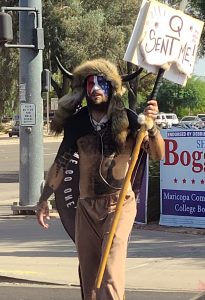 In “Reflections on a Christian Insurrection” appearing in Banner, a monthly publication of the Christian Reformed Church, editor in chief Shiao Chong argues that the mob break-in at the Capitol on January 6 was a “Christian insurrection.” Is this a fair claim? I read his article, looked up the sources he cited in support of his claim, and gave him every chance to convince me. He didn’t. I don’t think his claim is at all fair or accurate. For sake of space and keeping in mind my own expertise in religion and comparative amateur standing in politics, in this response I will focus on Chong’s claim that the event was a “Christian” one, and I will not address the claim that it was an “insurrection.”
In “Reflections on a Christian Insurrection” appearing in Banner, a monthly publication of the Christian Reformed Church, editor in chief Shiao Chong argues that the mob break-in at the Capitol on January 6 was a “Christian insurrection.” Is this a fair claim? I read his article, looked up the sources he cited in support of his claim, and gave him every chance to convince me. He didn’t. I don’t think his claim is at all fair or accurate. For sake of space and keeping in mind my own expertise in religion and comparative amateur standing in politics, in this response I will focus on Chong’s claim that the event was a “Christian” one, and I will not address the claim that it was an “insurrection.”
Chong points out that “the Christian presence in the mob was undeniable.” The evidence he cites, even if taken at face value and not fact-checked, would show only that some people involved in the event presented themselves as Christians. It would not prove that the event was “a Christian insurrection.” That is a broad generalization that unfairly contributes to the propaganda that Christian conservatives are as a whole somehow responsible for the break-in. Indeed, before the article is over, Chong will in effect make that accusation.
When we follow Chong’s links and attempt to confirm his statements, what we find does not help his generalization much. His first link is to an article in The Atlantic that asserts that some people who were marching toward the Capitol spoke about their belief in Jesus and the Bible, but the author admits he lost track of his group before they reached the Capitol. So he doesn’t know if any of those individuals actually entered the Capitol building. From his own account, most of the people in the group he followed were foul-mouthed, even pot-smoking individuals, whose identifiable affiliations were QAnon and the Proud Boys, not the Southern Baptist Convention (for example).
Chong says, “Many were waving Christian flags or flags with Christian sayings, such as “Jesus is My Savior.” A link for this statement takes us to the Religion Unplugged website, which features a large photo of a “Jesus 2020” banner well outside the Capitol building. That web article’s lead example of a Christian symbol inside the Capitol was a picture taken of Jake Angeli supposedly sitting in the Speaker’s chair. One dutifully clicks on the link to a Facebook tweet asserting, “This is Jake Angiel [sic] he sat in the Speakers chair,” which was meant to be two sentences: “This is Jake Angiel. He sat in the Speaker’s chair.” The photo shows Angeli (not Angiel) outside holding a sign that says, “Hold the line patriots. God wins.” Yes, that proves it! Evangelicals staged an insurrection at the Capitol! Except Angeli is not an evangelical. Wikipedia (no friend to evangelicals) has some interesting information about Mr. Angeli. He is a New Ager as well as a self-described “Qanon & digital soldier.” He is known online as the “QAnon Shaman” or “Q Shaman.” Angeli described the storming of the Capitol as “an evolution in consciousness… we were actually affecting the quantum realm.” Wikipedia reports, “Prosecutors have alleged that Angeli believes he is an alien or higher being, and he is destined to ascend to another reality.” And this is the face of the supposed “Christian insurrection”!
Pro tip for journalists writing on religion: The New Age movement is not Christian, and it certainly is not evangelical. Evangelicals write books and make videos criticizing New Agers.
Another link to Twitter that the Religion Unplugged article gives to document a “Christian flag” on the floor of the House of Representatives takes us to a feed on Twitter with one picture taken inside the Capitol somewhere with a flag visible, but one cannot tell if it’s a regular American flag or something different. There are, however, pictures of people in the march (not in the Capitol) with an “Iranians for Trump” sign and an Israeli flag!
The rest of the alleged evidence (for which no documentation is given) in the Religion Unplugged article concerns “Christian” paraphernalia supposedly spotted outside the Capitol. The lack of documentation and the admission that the evidence was seen outside the Capitol makes this supposed evidence meaningless to establish the claim that the event was a “Christian” insurrection.
The Religion Unplugged article did not quote any evangelicals, even though it is aimed at evangelicals who supported Trump. The author did, however, manage to quote an ex-evangelical podcaster and a retired Episcopal minister.
Going back to the Banner article, Chong adds more evidence of nefarious Christian involvement in the Capitol break-in: “Some carried crosses.” A link takes us to a photo on Buzz Feed of a man holding a cross somewhere outside, standing still, and praying. There is no evidence that this man was involved in storming the Capitol building. There were tens of thousands of people in Washington that day to show support for Trump. Only about eight hundred stormed the Capitol—maybe three percent or even less of the total crowds in Washington. (Reliable estimates of the total number of people in Washington that day for the Trump-related events are not available, but the National Park Service’s estimate the day prior was 30,000.) Indeed many of those tens of thousands of people were evangelical Christians (and again, many of them were not). To take a single photo of a man standing peacefully outside the Capitol praying with a cross and try to make that into evidence that the Capitol break-in was a “Christian insurrection” is journalistic malpractice.
Seemingly, the best evidence cited in the Banner article for Christian involvement is what Chong calls “a video of the insurrectionists praying a Christian prayer in the Senate chamber.” That sounds bad. But then we go to watch the video and guess who is actually making the “prayer”? It’s our consciousness-evolving, quantum-realm affecting, QAnon Shaman, Jake Angeli!
Here’s another pro tip for religion journalists: New Agers and other faux Christians (including the real “Christian” white supremacist groups such as “Christian Identity”) use Christian language when praying. That doesn’t make them Christians, and it certainly doesn’t make them evangelicals.
Chong then states, in a seemingly generous acknowledgment, “To be fair, I suspect there were many nonviolent Christians in the crowd who were probably caught by surprise at the sudden turn of events from what started out, for them, as a peaceful protest march.” No, that is not being “fair” at all. If Chong were being fair, he would have said that the vast, vast majority of people in the crowds for the march were nonviolent and peaceful. Again, apparently less than three percent of the people who showed up in Washington associated with the protest and march participated in the break-in at the Capitol.
The article could hardly get any worse, but Chong manages it. He asserts that because there were Confederate flags, other racist symbols, and even a rioter with a shirt saying, “Camp Auschwitz,” another result of the “insurrection” is that “Christianity is also tarnished by being linked to racism and anti-Semitism.” This is either hopeless ignorance or willful misrepresentation. Conservative evangelicals are the least anti-Semitic, most pro-Israel, pro-Jewish segment of America today—even more pro-Israel than American Jews as a whole!
There were indeed racist groups involved in the Capitol break-in, but they were not evangelical groups, nor is there any evidence of significant involvement by evangelical individuals in these groups. How many evangelicals would one expect to be involved in the “Kekistan” group ruled by a frog-headed deity, or in neo-Nazi groups, or in the Black Hebrew Israelites? These are some of the groups identified in the Insider article that Chong cites as documentation of “racist symbols” of those who entered the Capitol building. We should also note that apparently only a small percentage (on the order of ten percent) of the identified participants in the Capitol break-in have identifiable ties with white nationalist or other extremist groups.
By the way, for those who may be tempted to connect Christianity to the Nazis: No, Hitler was not a Christian.
Chong proceeds to flog “Christian nationalism,” another broad generalization that allows him to criticize essentially all conservatives who voted for Trump as “either ambassadors or accommodators of Christian nationalism.” Specifically, he claims that 78 percent of all self-described evangelicals fall into one or the other category. This is suspiciously about the same figure as the percentage of evangelicals who voted for Trump (estimated at between 76 and 81 percent). In short, the claim that is being made is that virtually all (and we could probably drop the word “virtually”) evangelical Trump supporters are either Christian nationalists or people who “accommodate” Christian nationalism. What is Christian nationalism? It “includes assumptions of nativism, white supremacy, patriarchy, and heteronormativity, along with divine sanction for authoritarian control and militarism.” It would take another piece as long as this one to deconstruct this litany of accusations against tens of millions of American evangelicals. The short explanation is that if, for example, you don’t accept critical race theory, if you think same-sex marriage is wrong, and if you favor a strong U.S. military, and you identify as a Christian, you’re a Christian nationalist.
Toward the end of his article, Chong again attempts to sound fair-minded, commenting: “If we show grace to Black Lives Matter protestors over last summer, which we should, we ought to show some grace here too.” But he does nothing of the kind. He had just smeared tens of millions of American Christians (mostly evangelicals). In a link, Chong points to an article he had written last year on the BLM protests. That article does not “show grace to Black Lives Matter protesters”; it aggressively takes side with the movement and makes excuses for it. This is about the extent of Chong’s criticism of BLM: “Yes, BLM has problems. But so does every movement in history, including Christianity. Besides, not every BLM activist agrees with each other.” Funny how the fact that not every Trump supporter agrees with one another does not prevent Chong from pronouncing sweeping generalizations about them being at least complicit in Christian nationalism.
In that article, Chong claims that he is “not condoning violence of any kind,” but he is understanding and sympathetic to the BLM and related rioters in stark contrast to his attitude toward the Capitol rioters. The BLM rioters’ violence was, Chong says, “lamentable, though understandable,” and he is quick to say, “But we should not lump the vast majority of peaceful protestors with the small minority of rioters who may or may not even be associated with the protest.” Contrast this comment with his weak admission in the article on the Capitol break-in, “I suspect there were many nonviolent Christians in the crowd” (my emphasis). If Chong had treated BLM in the same way he later treated the “Christian nationalists” who broke into the Capitol, he would have linked to a few photos of BLM protesters carrying signs appealing to Jesus in support of their protest (“Black Lives Matter! Jesus Thinks So Too!”) and from there generalized about the dangers of the millions of Christian “ambassadors” and “accommodators” of BLM being responsible for the violence at the “mostly peaceful” BLM riots.
Chong then launched into the usual defensive stance: “However, focusing on the rioting and destruction of property has become another act of unhearing. Do we really want to emphasize the destruction of property over the killing and oppression of black lives? Rather, as someone who is pro-life ‘from the womb to the tomb,’ I will emphasize people’s lives over property.” However, according to an article in The Guardian back in October 2020, which attempts to present the facts in as favorable a way to BLM as it can, “At least 11 Americans have been killed while participating in political demonstrations this year and another 14 have died in other incidents linked to political unrest.” This included two police officers shot during protests; there were also at least four police offers injured in such events, and a retired African-American police officer was shot during a robbery (“alleged looting”). Chong’s polemic completely ignores these deaths and injuries.
No responsible person wants to “emphasize” the wrong of property damage “over” the killing or oppression of black lives. That is a complete misrepresentation of what conservative critics of BLM think about the subject. We should unqualifiedly condemn both killing and deliberate destruction of private and public property.
This background concerning Chong’s defensiveness toward BLM is necessary background for understanding what came next in that article. Put your cup down first….
Even Jesus staged a one-man riot (Mark 11:15-19). A riot is defined as a violent disturbance of the peace. Jesus overturned the tables belonging to money changers and merchants in the Jerusalem temple, driving people out who were buying and selling. This was not a minor inconvenience…. Race, or ethnicity, was part of Jesus’ protest riot, too…. Jesus’ protest of the temple, then, condemns not only fusing religion with unjust economic practices but also fusing religion with ethnic exclusion/segregation, a precursor of our modern racism. Given this biblical context, do you think Jesus would more likely support the protests for racial justice or complain about the destruction of property?
Yes, he went there.
Here is how Merriam-Webster defines riot: “a tumultuous disturbance of the public peace by three or more persons assembled together and acting with a common intent.” That is a legal definition, also given at Dictionary.com, along with this more informal definition: “a noisy, violent public disorder caused by a group or crowd of persons, as by a crowd protesting against another group, a government policy, etc., in the streets.” Cambridge Dictionary gives a similar definition: “an occasion when a large number of people behave in a noisy, violent, and uncontrolled way in public, often as a protest.”
There is no such thing as “a one-man riot.”
Apparently, according to Chong, looting, burning cars and buildings, destroying businesses (often black-owned businesses!), taking over or damaging police stations and government offices, and other acts of violence are “lamentable but understandable” collateral damage of righteous protests that we should “support” (Chong’s word) if it’s for the right cause. If innocent people (even black people!) are killed or injured in the mayhem, we will try not to mention it, and if we must mention it then we will minimize it. And Jesus’ act of forcibly driving out moneychangers from the temple supposedly is precedent. Yet, somehow, Chong, as a professing Christian, citing Jesus to justify riots from the left is not problematic, whereas conservative Christians publicly displaying their faith in Jesus while engaging in a protest on the right (i.e., the thousands of Christians who participated peacefully in the march on January 6) damages “our moral credibility.”
In the immediate aftermath of the storming of the Capitol on January 6, conservative politicians and Christian religious leaders (evangelical and otherwise) rushed en masse to condemn the incident. (Some speculated at first, wrongly as it turned out, that the break-in was led by Antifa or other left-wing agitators, precisely because the actions of those who broke into the Capitol were so out of character for traditional conservatives.) Within a few days, there were probably hundreds of statements issued by such influencers unequivocally condemning the criminal actions of the persons involved. No such response came from liberals or progressives in response to the months of violence all around the country that took place in the cause of BLM. Chong’s response was actually fairly typical: We don’t condone violence, but shut up about the violence.
To sum up:
The break-in at the Capitol was not a Christian insurrection. It was not a Christian action. It had no support or approval from any mainline, liberal, or evangelical Christian church or leader. It certainly was not staged by evangelical Christians. Almost all, if not literally every single one, of the evangelical Christians in Washington on that day were outside the Capitol when it happened—with the exception of the evangelicals who were supposed to be there, namely those who were in Congress. The face of the Capitol break-in was a New Age shaman, not an evangelical Protestant. Evangelicals are not anti-Semitic; they are Israel’s best friends. Very, very few white evangelicals are racists, though admittedly by the standard of critical race theory they are all racists by default, regardless of how they feel and act toward people of color. The people who participated in the Capitol break-in do not represent Christianity, and they certainly don’t represent evangelical Christianity. As one of the tens of millions of evangelical Christians in America who love the Lord Jesus Christ, who seek to honor him in the way we live, and who are law-abiding, peaceful, responsible citizens, I will not remain silent while such misrepresentations about us are spread through social media. I hope you won’t, either.
 In a follow-up video to her earlier video arguing that Paul did not persecute Christians, which I discussed in my previous blog post, Robyn Walsh offers another argument in defense of her claim. In this video, she reports that two classicists had told her that the two verbs used in Galatians 1:13 in reference to Paul’s pre-Christian treatment of Christians were “conative” imperfects, meaning that Paul had tried to persecute and destroy the church but hadn’t actually persecuted it. I’ll quote her at length to make sure I’m representing her claim accurately:
In a follow-up video to her earlier video arguing that Paul did not persecute Christians, which I discussed in my previous blog post, Robyn Walsh offers another argument in defense of her claim. In this video, she reports that two classicists had told her that the two verbs used in Galatians 1:13 in reference to Paul’s pre-Christian treatment of Christians were “conative” imperfects, meaning that Paul had tried to persecute and destroy the church but hadn’t actually persecuted it. I’ll quote her at length to make sure I’m representing her claim accurately: I can’t stand it. I just can’t stand it when scholars play fast and loose with the facts.
I can’t stand it. I just can’t stand it when scholars play fast and loose with the facts.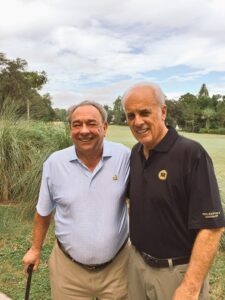 Posts are showing up on Facebook arguing that it is theologically incorrect to affirm that the incarnate Christ is “fully God and fully man.” Supposedly, these expressions should be avoided in favor of the creedal wording “truly God” and “truly man.” One individual claimed that “the orthodox” have rejected the description “fully” in this context. (I’ll just comment right here that there is zero support for this claim.) Another claimed that these expressions “misrepresent” orthodox Christianity, even asserting that the only correct word to use in this context is the word “truly.” A common complaint is that “fully” is at best “sloppy” and is at least potentially heretical. The basic argument against the word “fully” is that it supposedly leads to or implies the contradictory position that Jesus is only God and that he is only man, rather than both God and man.
Posts are showing up on Facebook arguing that it is theologically incorrect to affirm that the incarnate Christ is “fully God and fully man.” Supposedly, these expressions should be avoided in favor of the creedal wording “truly God” and “truly man.” One individual claimed that “the orthodox” have rejected the description “fully” in this context. (I’ll just comment right here that there is zero support for this claim.) Another claimed that these expressions “misrepresent” orthodox Christianity, even asserting that the only correct word to use in this context is the word “truly.” A common complaint is that “fully” is at best “sloppy” and is at least potentially heretical. The basic argument against the word “fully” is that it supposedly leads to or implies the contradictory position that Jesus is only God and that he is only man, rather than both God and man.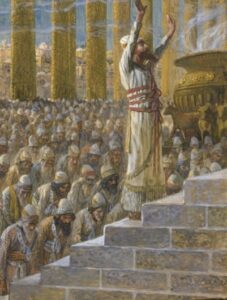
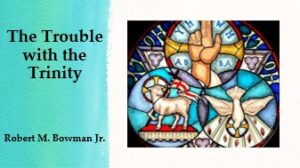 This week I spoke at the
This week I spoke at the 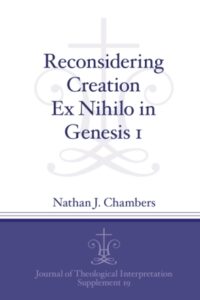 Jews and Christians often quote Genesis 1:1 in support of the belief that God created the universe out of nothing (Latin, ex nihilo). Biblical scholars, however, often challenge the use of Genesis 1:1 to support creation ex nihilo. Note how the following two English translations of Genesis 1:1-2a read very differently:
Jews and Christians often quote Genesis 1:1 in support of the belief that God created the universe out of nothing (Latin, ex nihilo). Biblical scholars, however, often challenge the use of Genesis 1:1 to support creation ex nihilo. Note how the following two English translations of Genesis 1:1-2a read very differently: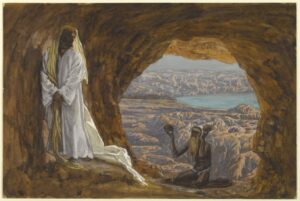
 In “
In “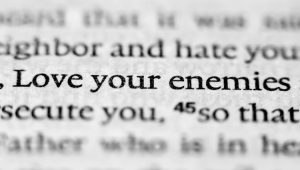 One of the unfortunate developments of 2020 in America and no doubt many other parts of the world was the exacerbation of divisions between people over political, cultural, and religious differences. The political divide between the left and the right in the United States has become a wide chasm, with some (not all) voices on both sides openly expressing hatred for the other. Jesus’ instruction in this matter is just as challenging today as ever:
One of the unfortunate developments of 2020 in America and no doubt many other parts of the world was the exacerbation of divisions between people over political, cultural, and religious differences. The political divide between the left and the right in the United States has become a wide chasm, with some (not all) voices on both sides openly expressing hatred for the other. Jesus’ instruction in this matter is just as challenging today as ever: So, you want to get serious about studying the Bible! You’re not a biblical scholar, and not necessarily planning on going that direction, but you’re motivated to work on getting a solid, working knowledge of the whole Bible. Maybe you feel that you are already pretty familiar with the Bible, but you realize you could go a lot deeper. If this sounds at all like you, here are five books that I highly recommend you consider getting. Prices are listed as found on January 1, 2021, on Amazon, and are subject to frequent change. These are not books written for scholars but rather popular books that have sold many copies and are well-liked by regular Christian readers.
So, you want to get serious about studying the Bible! You’re not a biblical scholar, and not necessarily planning on going that direction, but you’re motivated to work on getting a solid, working knowledge of the whole Bible. Maybe you feel that you are already pretty familiar with the Bible, but you realize you could go a lot deeper. If this sounds at all like you, here are five books that I highly recommend you consider getting. Prices are listed as found on January 1, 2021, on Amazon, and are subject to frequent change. These are not books written for scholars but rather popular books that have sold many copies and are well-liked by regular Christian readers.